Scattering of light makes the sky appear blue, clouds white, and
turns the sun red at sunset.
A simple demonstration will give you a pretty good idea what scattering
is.
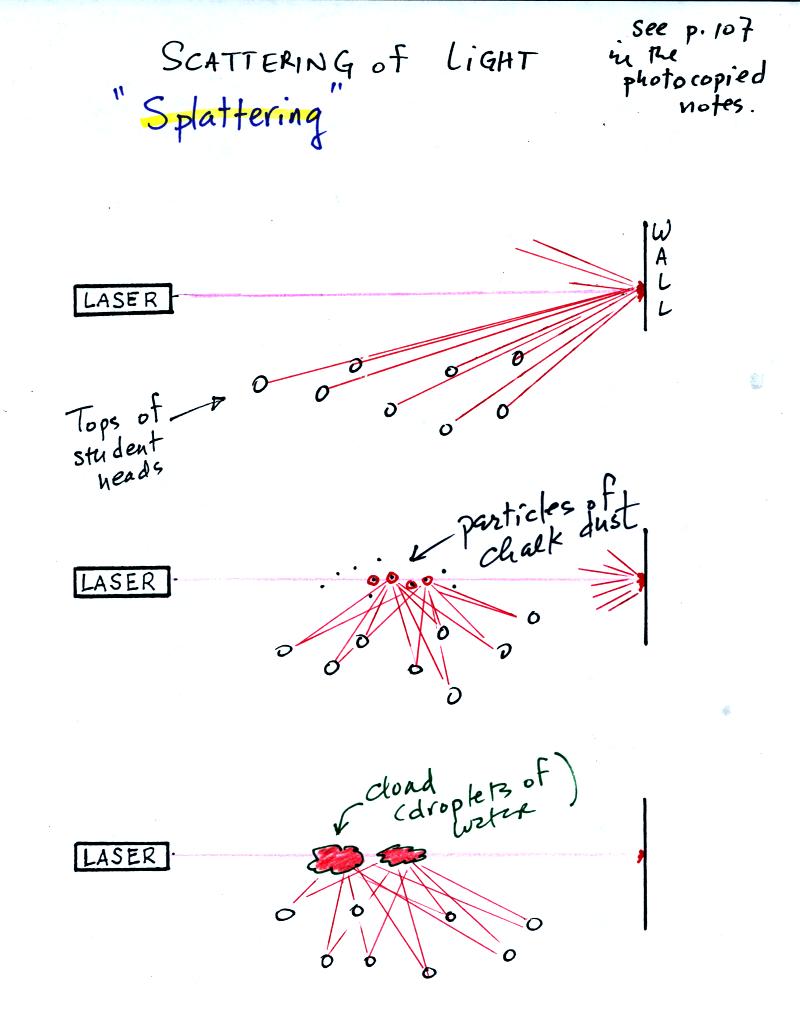
A thin beam of bright red laser light was shined across the front of
the classroom. No one in the class could see this beam of
light. To see the beam you would need to stand over where the
beam struck the wall and look back toward the laser (the laser light is
intense enough that you shouldn't do this - it could damage your
eyes).
Students in the class could see a red spot on the wall because the
light hitting the wall was scattered or splattered and sent off in a
multitude of directions. A ray of that light was sent to everyone
in the class (and because the intense light is split up into many rays,
these rays are weaker and safe to look at).
Next we clapped a couple of chalkboard erasers together. When
particles of chalk dust fell into the laser beam they intercepted some
of the laser light and scattered it. Again everyone in the room
got their own personal ray of light coming from each of the particles
of chalk. We use chalk because it is white, it scatters rather
than absorbs light. What would you have seen if black particles
of soot had been dropped into the laser beam?
In the 3rd part of the demonstration we made a cloud by pouring some
liquid nitrogen into a cup of water. The numerous little water
droplets made very good scatterers. So much light was scattered
that the spot on the wall fluctuated in intensity (weak when lots of
light is being scattered, brighter when not as much light was
scattered).
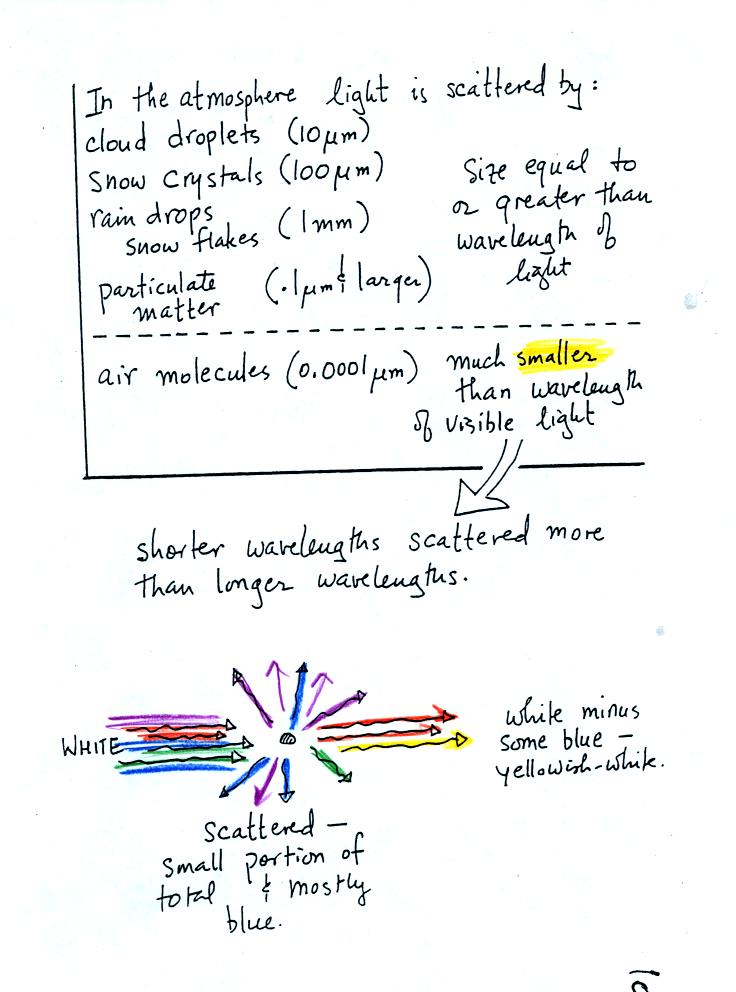
Just about everything in the atmosphere can scatter light (some
particles and gases might absorb light). These scatterers fall
into two categories: (1) those that have sizes equal to or greater than
the wavelength of the light being scattered and (2) those that are much
smaller. Air molecules fall into the 2nd group. Members of
this group scatter short wavelengths of light much more readily than
long wavelengths. We will see what effects this has.
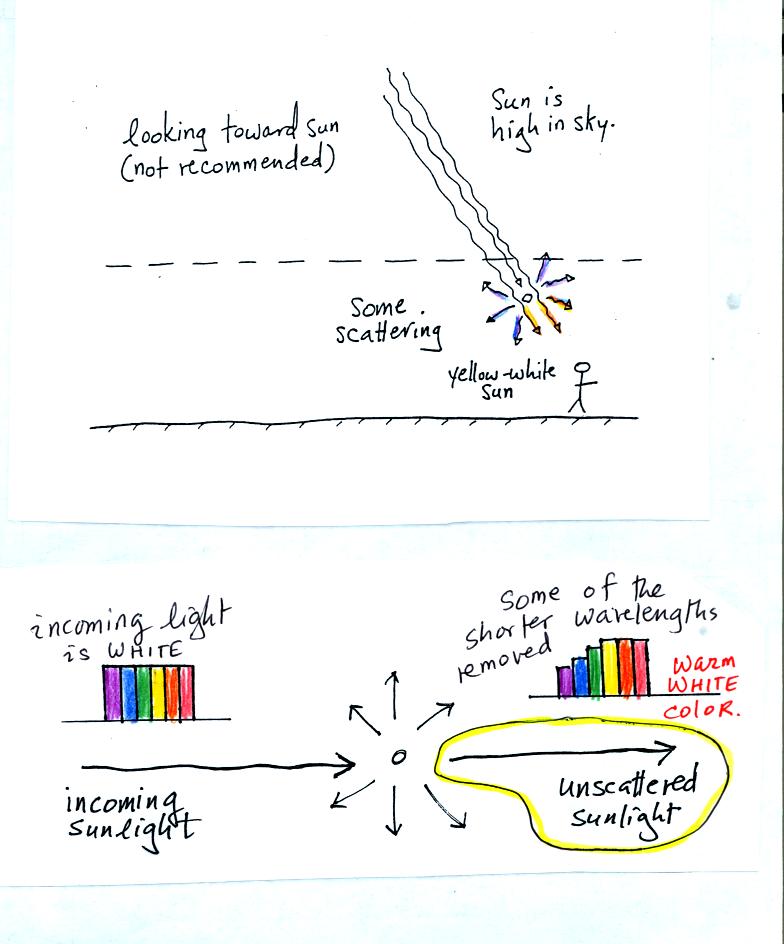
In this first figure we imagine going outside at midday, turning toward
the south and looking up at the sun when it is high in the sky (you
shouldn't do this of course, sunlight is too intense and will blind
you). We assume that the sunlight arriving at the top of the
atmosphere is made up of equal amounts of all the colors. This
isn't true, but that's what we'll assume. As the sunlight passes
through the atmosphere some of the shorter wavelengths will be
scattered by air molecules. The unscattered light that makes it
to the ground will be most of the original red, orange, and yellow with
some of the green, blue, and violet light removed. The resulting
mixture will be a warm white color.
If you were to turn toward the north, away from the sun and look up at
the sky you see blue light.
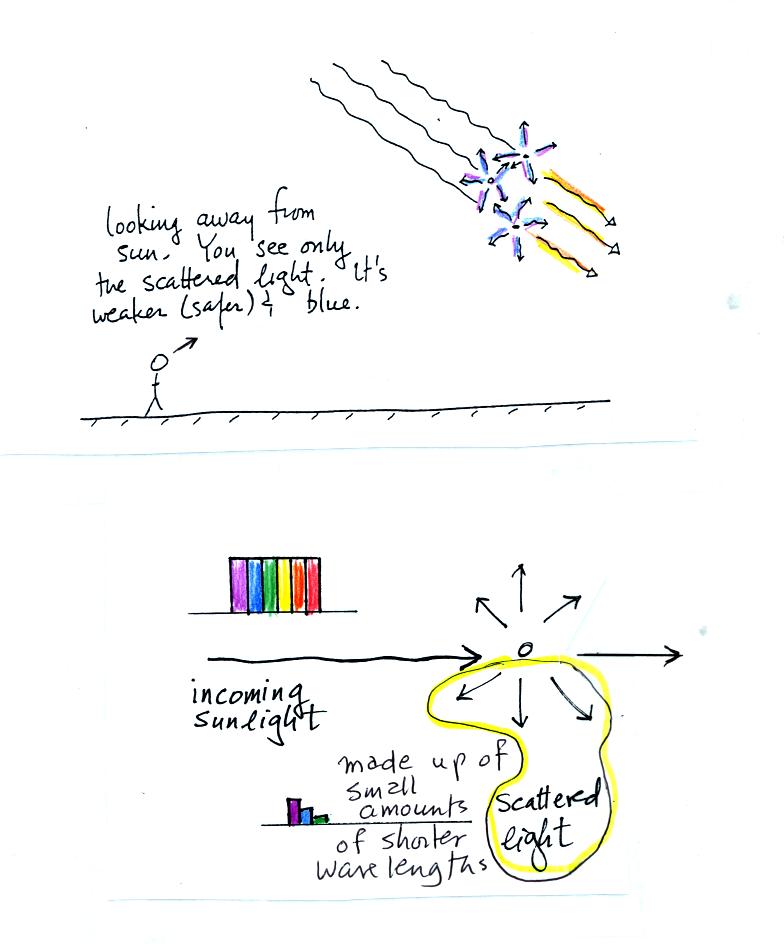
First of all you see light coming from the sky because some of the
sunlight has been intercepted by air molecules and redirected (just
like the chalk dust and cloud droplets made the laser beam visible in
the demonstration). The sky would appear black if it weren't for
the fact that air molecules scattered light.
Two things to notice about this scattered light: first it is much
weaker than the unscattered sunlight and is safe to look at (imagine if
that weren't the case and it was dangerous to look at the sky), second
the light is blue because it is mainly the shorter wavelengths that are
being scattered.
Why is the sky blue and not green or violet? The sky isn't violet
because there isn't as much violet light in sunlight as there is green
and blue. Also our eyes might not be as sensitive to violet as
they are to blue and green. The sky probably isn't green because
that color isn't scattered as readily as the blue and violet
light. Blue is a sort of compromise.
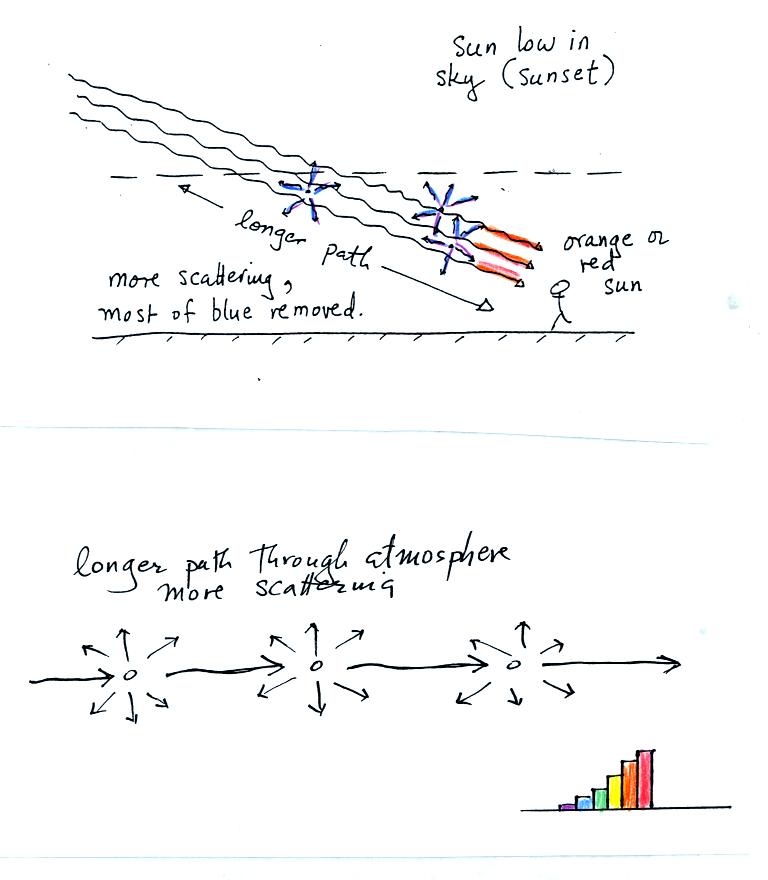
You might have noticed looking west late in the day that the setting
sun is not as bright and is redder than it is at midday (it is still
not safe to look at the setting sun). The sunlight follows a much
longer path through the atmosphere at this time of day and much more of
the sunlight is scattered. Essentially all of the shorter
wavelengths are removed from the unscattered beam of light. You
are left with a mixture of yellow, orange, and red. Sometimes
just the orange and red light are left.
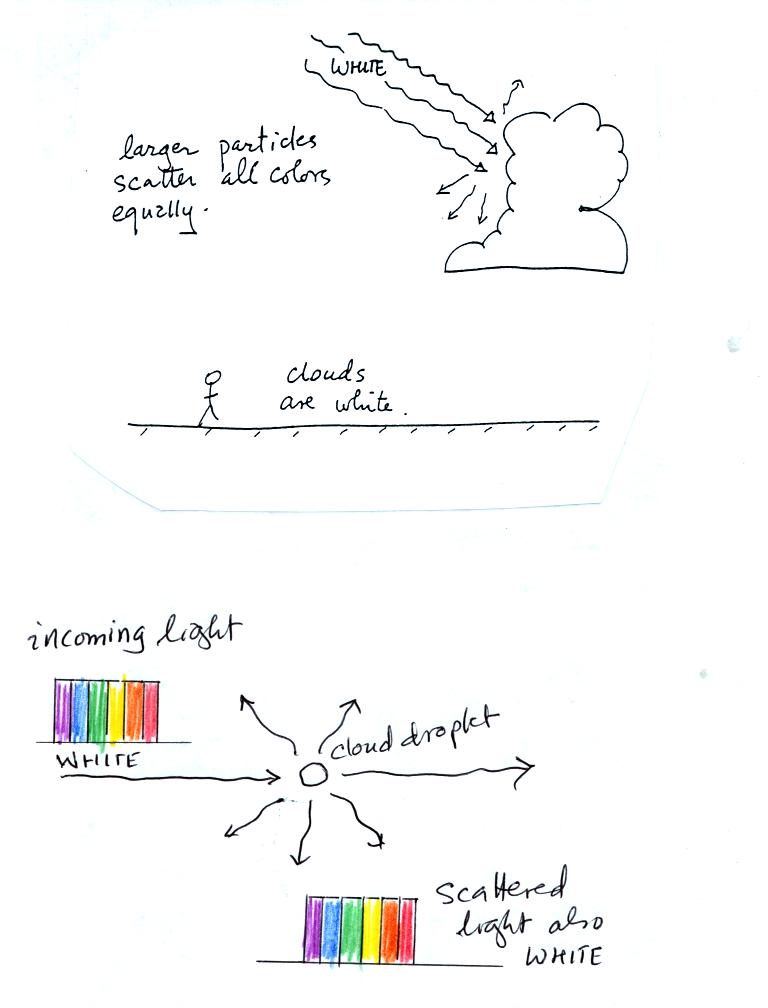
As we saw with the laser demonstration, the water droplets in clouds
are very good scatterers of light. The cloud droplets (typically
around 10 or 20 micrometers in diameter) are larger than the wavelength
of visible light (0.4 to 0.7 micrometers). Cloud droplets scatter
all of the colors equally. When white light strikes a cloud, the
scattered light is also white.
Here are a
couple of more common phenomena produced by the scattering of light (these weren't mentioned in class)
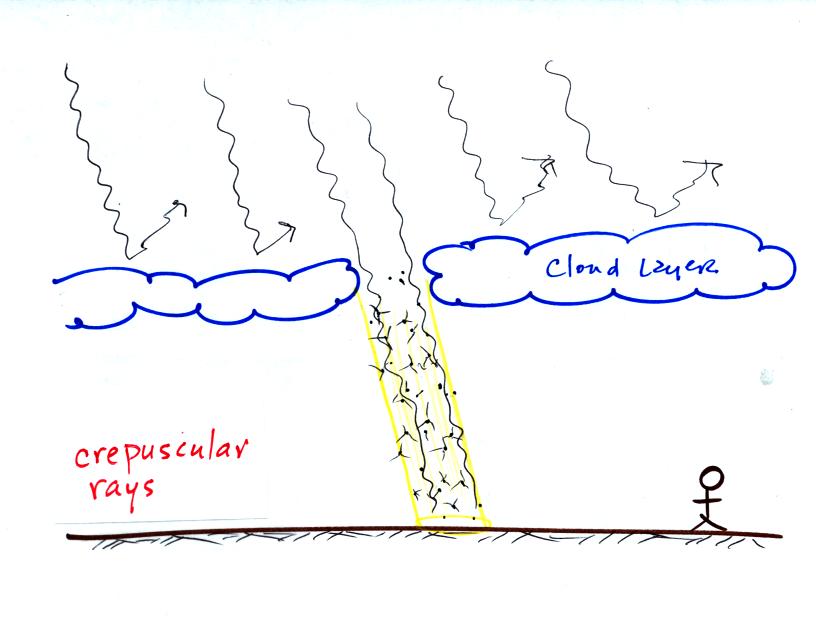
The person in this figure would see a crepuscular ray, a shaft of
sunlight that passes through a hole in a cloud layer. The
sunlight is scattered by particles in the air. Rays of sunlight
that would ordinarily pass through the adjacent parts of the sky are
reflected by the clouds. These parts of the sky appear
darker. You'll find a nice photograph of crepuscular rays on in
Fig. 15.6 on p. 407 in the textbook (p. 403 in the 3rd ed.).
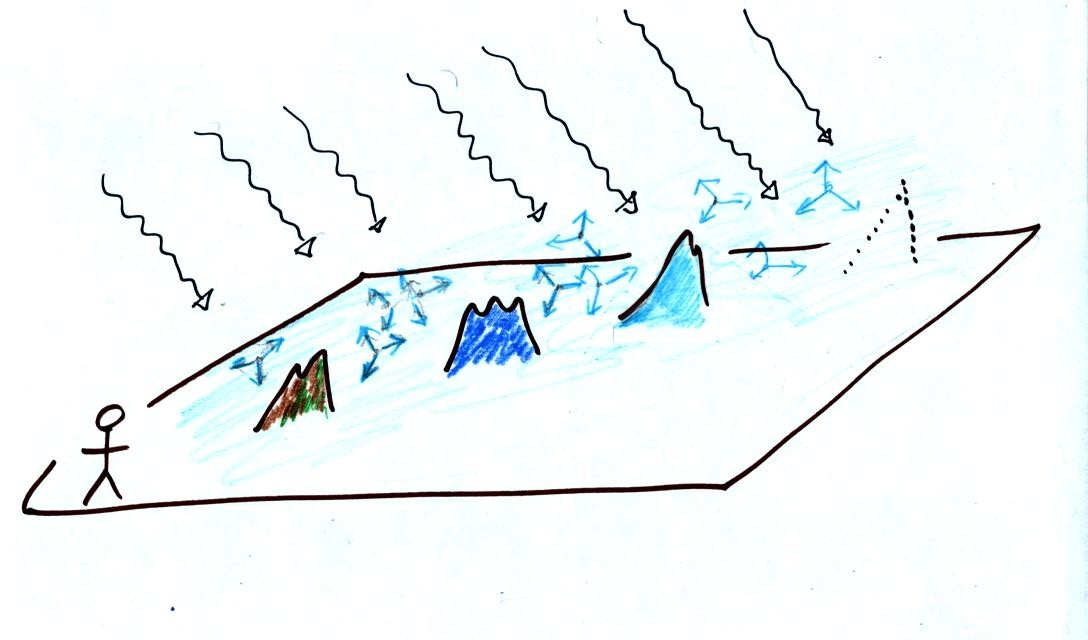
Scattering of sunlight by air molecules turns distant mountains blue
and eventually makes them fade from view (there is a limit to how far
you can see even when the air is very clean).
A nearby mountain might appear dark green or brown. You are
mainly seeing light reflected off the mountain. As the mountain
gets further away you start seeing appreciable amounts of blue light
(sunlight scattered by air molecules). As the mountain gets even
further the amount of this blue light from the sky increases.
Eventually the mountain gets so far away that you only see blue sky
light and none of the light reflected by the mountain itself.
You'll find a nice photograph of the changing colors of distant
mountains in Fig. 15.5 on p. 406 in the text (p. 402 in the 3rd ed.)







